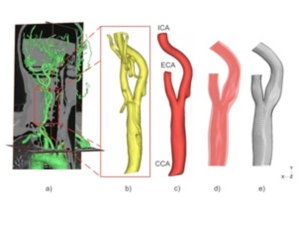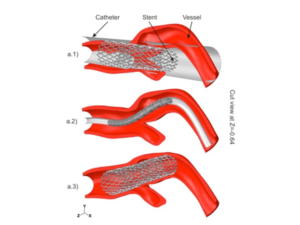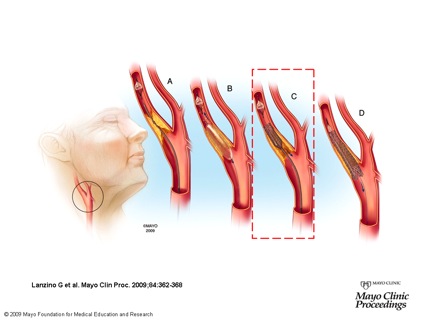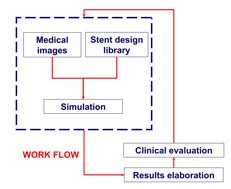Background
The widespread acceptance of Carotid Artery Stenting (CAS) – see Figure 1 – is still a matter of debate and clinical experts underline that CAS outcomes are strongly related to operator skills and to an appropriate selection of patients and devices. Consequently there is a significant need to develop dedicated tools for both procedure planning and device selection in order to relate the device features with the target vascular anatomy.
Fig. 1: Carotid Artery Stenting (CAS) procedure; a) through a guidewire an embolc filter is driven above the stenosis and deployed; b) ballon angioplasty is performed to enlarge the stenosis, at this stage some clots can be released and should be captured by the filter; c) deployment of self-expanding Nintinol stent; d) filter retrieval. The RED box highlights the procedure step investigated by Finite Element Analysis (FEA).
Aim
The present study proposes a virtual framework (see Figure 2) aiming to evaluate the performance of different stent designs in a patient-specific carotid artery model through finite element analysis.
In particular, we compare two different laser-cut self-expanding Nitinol stent designs (open-cell versus closed-cell).
Fig. 2: Work-flow of the virtual framework to assess the stent performance in a given patient-specific carotid artery anatomy: starting from medical images, we develop the patient-specific CA model; we combine the vessel model with a given stent model available within a predefined stent design library to perform a simulation of CAS through FEA; the results are elaborated to assess clinically relevant parameters of stenting performance (e.g. lumen gain or vessel straightening). The framework allows to investigate virtual scenarios and to perform an evaluation loop aiming at supporting the CAS procedure planning.
Materials and Methods
Starting from computed angiography tomography (CTA) images, we firstly assess the vessel lumen using Mimics v.13 (Materialise, Leuven, Belgium); then we define the vessel wall thickness and the related hexahedral mesh. For each stent model, we perform the simulation of its deployment in the artery (see figure 3), analyzing the impact on the vessel with respect to induced stress, induced strain, lumen gain and vessel straightening.

Fig. 3: Patient-specific CA model: a) 3D reconstruction of vascular tree using Mimics v. 13; b) lumen of CA bifurcation with also secondary branches; c) lumen of CA main branches (CCA: common carotid artery; ICA: internal carotid artery; ECA: external carotid artery); d) CA lumen (dark red) and reconstructed outer vessel wall profile (light red); e) hexahedral mesh.

Fig. 4: a) Simulation of stent implant for stent B: a.1) starting configuration of the FE model; a.2) stent crimped in the delivery system; a.3) stent deployed in the vessel.
Results
For the analyzed artery, the results indicate that the closed-cell design provides higher lumen gain and that, although the open-cell design A has a slightly minor impact than the design B on vessel tortuosity, both stents straighten the vessel considerably. We believe that the present study represents a solid base for further developments aiming to define a reliable virtual procedure planning of CAS supporting, on the one hand, the assessment of procedure standardization, and, on the other hand, relating complex mechanical features of a given stent design to a given patient-specific anatomy.
Acknowledgements
This work investigation has been carried out in collaboration with:
– IBiTech, Ghent University, Ghent, Belgium.
– IRCCS, Policlinico San Matteo, Pavia, Italy (Dr. A. Odero, Dr. S. Pirrelli, Dr. R. Dore).
Group publications
- [P1] F. Auricchio, M. Conti, M. Ferraro, A. Reali. Evaluation of carotid stent scaffolding through patient-specific finite element analysis. International Journal of Numerical Methods in Biomedical Engineering, 28(10): 10431055 (2012).
- [P2] F. Auricchio, M. Conti, A. Ferrara, S. Morganti, A. Reali. Patient-specific finite element analysis of carotid artery stenting: a focus on vessel modeling. International Journal of Numerical Methods in Biomedical Engineering, available online (doi: 10.1002/cnm.2511)
- [P3] M. Conti, D. Van Loo, F. Auricchio, M. De Beule, G. De Santis, B. Verhegghe, S. Pirrelli, A. Odero. Impact of carotid stent cell design on vessel scaffolding: a case study comparing experimental investigation and numerical simulations. Journal of Endovascular Therapy, 18(3): 397-406 (2011).
- [P4] F. Auricchio, M. Conti , M. De Beule, G. De Santis, B. Verhegghe. Carotid Artery Stenting Simulation: from patient-specific images to Finite Element Analysis. Medical Engineering & Physics, 33(3): 281-289 (2011).



